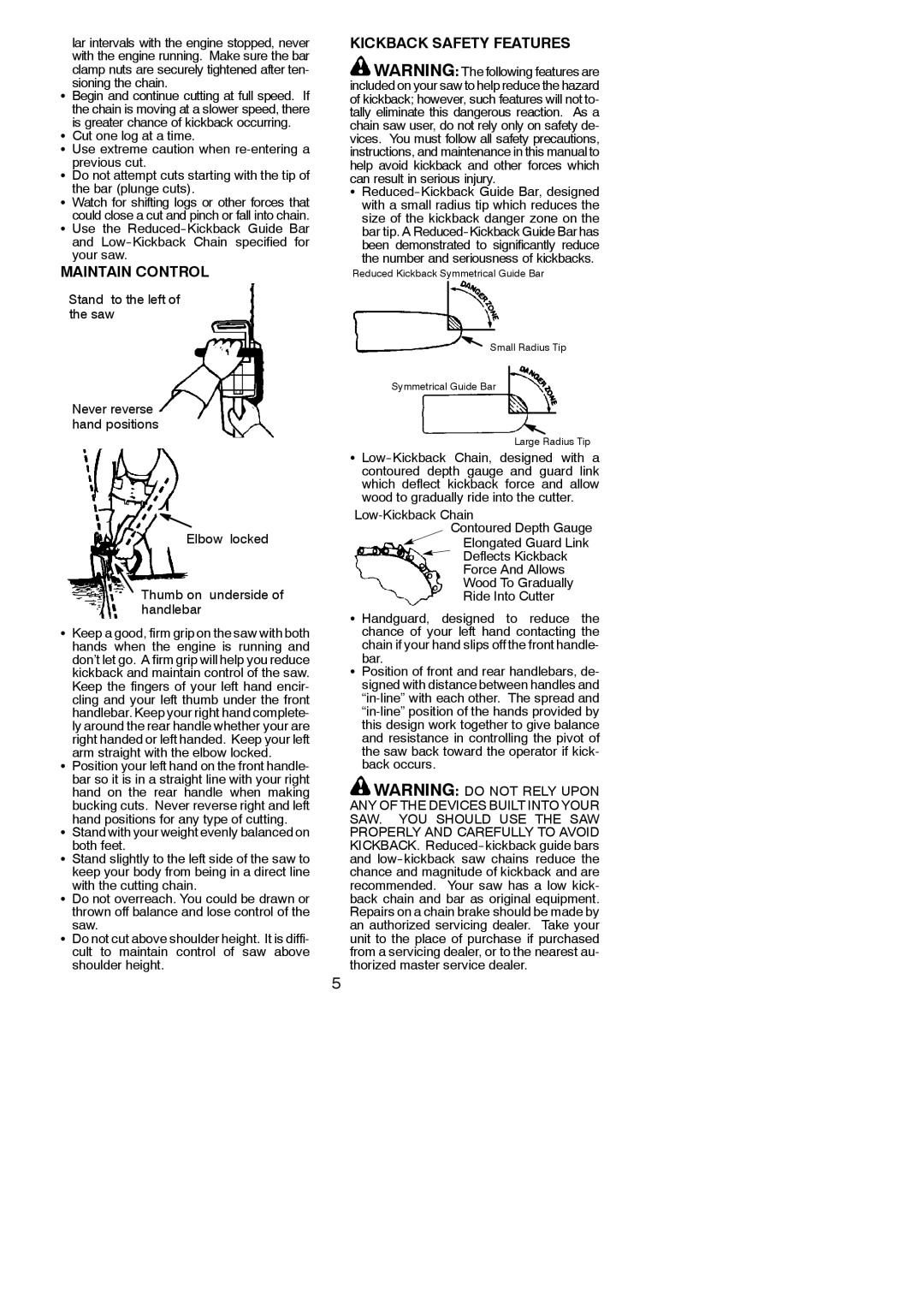
lar intervals with the engine stopped, never with the engine running. Make sure the bar clamp nuts are securely tightened after ten- sioning the chain.
SBegin and continue cutting at full speed. If the chain is moving at a slower speed, there is greater chance of kickback occurring.
SCut one log at a time.
SUse extreme caution when
SDo not attempt cuts starting with the tip of the bar (plunge cuts).
SWatch for shifting logs or other forces that
could close a cut and pinch or fall into chain.
SUse the
MAINTAIN CONTROL
Stand to the left of the saw
Never reverse hand positions
Elbow locked
![]() Thumb on underside of handlebar
Thumb on underside of handlebar
SKeep a good, firm grip on the saw with both hands when the engine is running and don’t let go. A firm grip will help you reduce kickback and maintain control of the saw. Keep the fingers of your left hand encir- cling and your left thumb under the front handlebar. Keep your right hand complete- ly around the rear handle whether your are right handed or left handed. Keep your left
arm straight with the elbow locked.
SPosition your left hand on the front handle- bar so it is in a straight line with your right hand on the rear handle when making bucking cuts. Never reverse right and left
hand positions for any type of cutting.
SStand with your weight evenly balanced on
both feet.
SStand slightly to the left side of the saw to keep your body from being in a direct line
with the cutting chain.
SDo not overreach. You could be drawn or thrown off balance and lose control of the saw.
SDo not cut above shoulder height. It is diffi- cult to maintain control of saw above shoulder height.
KICKBACK SAFETY FEATURES
![]() WARNING: The following features are included on your saw to help reduce the hazard of kickback; however, such features will not to- tally eliminate this dangerous reaction. As a chain saw user, do not rely only on safety de- vices. You must follow all safety precautions, instructions, and maintenance in this manual to help avoid kickback and other forces which can result in serious injury.
WARNING: The following features are included on your saw to help reduce the hazard of kickback; however, such features will not to- tally eliminate this dangerous reaction. As a chain saw user, do not rely only on safety de- vices. You must follow all safety precautions, instructions, and maintenance in this manual to help avoid kickback and other forces which can result in serious injury.
S
Reduced Kickback Symmetrical Guide Bar
Small Radius Tip
Symmetrical Guide Bar
Large Radius Tip
S
Contoured Depth Gauge Elongated Guard Link
Deflects Kickback Force And Allows Wood To Gradually Ride Into Cutter
S Handguard, designed to reduce the chance of your left hand contacting the chain if your hand slips off the front handle- bar.
SPosition of front and rear handlebars, de- signed with distance between handles and
![]() WARNING: DO NOT RELY UPON ANY OF THE DEVICES BUILT INTO YOUR SAW. YOU SHOULD USE THE SAW PROPERLY AND CAREFULLY TO AVOID KICKBACK.
WARNING: DO NOT RELY UPON ANY OF THE DEVICES BUILT INTO YOUR SAW. YOU SHOULD USE THE SAW PROPERLY AND CAREFULLY TO AVOID KICKBACK.
5
